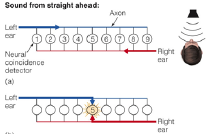![]()
![]()
![]()
Use LEFT and RIGHT arrow keys to navigate between flashcards;
Use UP and DOWN arrow keys to flip the card;
H to show hint;
A reads text to speech;
14 Cards in this Set
- Front
- Back
|
Name the 6 auditory grouping principles (and define what auditory grouping principles do) |
Auditory grouping principles help us organize elements of the auditory scene: 1. Onset time 2. Familiarity/Effect of past experience 3. Similarity of timbre and pitch 4. Proximity in time 5. Auditory continuity 6. Location |
|
|
In the auditory space (the area of sounds surrounding an observer), what are the 3 dimensions? |
Azimuth = left to right Elevation = up and down Distance from observes |
|
|
In what area can people localize sound most accurately? Least accurately? |
Most accurately: In front of them Least accurately: to the sides and behind them |
|
|
What are binaural localization cues and how are they defined? What dimension are they best for? |
Binaural cues means using both ears. Best for azimuth 2 kinds: -- ITD (Interaural time difference) = amount of time it takes to reach one ear vs the other -- ILD (Interaural level difference) = difference in amplitude (volume/sound pressure) reaching the two ears |
|
|
For ITD, what frequencies is it best for? If the distance to each ear from the source is the same, what's the ITD? |
ITD is best for low frequency tones below 800Hz (may use temporal coding/phase locking). When distance to each ear is same, ITD = 0 |
|
|
For ILD, what frequencies is it best at? What is an acoustic shadow? |

ILD is best for high frequency sounds above 800Hz. An acoustic shadow is a reduction in intensity for the far ear as a result of the head blocking/absorbing some sound. The further off to the side a sound source is, the greater the shadow and ILD. |
|
|
What's the main weakness of ILD and ITD? What's the main strength of ILD and ITD |
Weakness: Neither of them provide good cues for detecting elevation. ---Results in the cone of confusion Strength: They're good for side to side detection (azimuth- right and left)
|
|
|
What is the one monaural cue we studied? What dimension is it best for localizing? |
Monaural cue = only 1 ear. Best for elevation HRTF (Head-Related transfer function) = is unique to each head because the pinna and the head affect the intensities of the frequencies. is a spectral cue because the info for location comes from the spectrum of frequencies. |
|
|
Why are we best at localizing sounds in front of us? What do we also use besides ILD and ITD to localize sounds? |
Because perception is an active process, we orient ourselves to make ITD and ILD zero in front of us. We also expectations (top down info) and spectral cues (HRTF) to localize sounds. All the cues work together effectively, but are mainly for orienting. |
|
|
What are the two basic approaches for the physiological representation of auditory space? |
Narrowly Tuned ITD Neurons: (specificity coding) one neuron gives a location by responding to a specific time difference Broadly Tuned ITD Neurons: (distributed coding) respond to a broad range of time differences, location is calculated from a range of neural responses |
|
|
What is the Jeffress Model for narrowly tuned ITD neurons? |

These neurons receive signals from both ears. If they receive at... -- the same time (ITD = 0) , the signals from both will meet in the middle and fire at the coincidence detector. -- different times, (ITD isn't 0) the coincidence detector doesn't fire |
|
|
What is some implementational-level evidence for narrowly tuned ITD neurons (specificity coding)? |
single cell recordings from owls show that neurons in the inferior colliculus and superior olivary nuclei respond to a narrow range of interaural time differences (ITD). |
|
|
What is some implementational-level evidence for broadly tuned (distributed) ITD neurons? |
In gerbils, scientists found that neurons in the left hemisphere respond best to sound from the right (and vice versa), and that the location of sound is determined by the ratio of responding to left and right sensitive neurons |
|
|
What did we learn from the gerbils and owls examples demonstrating broadly and narrowly tuned ITD neurons? |
Mammals and birds use different encoding systems. -- mammals = broadly distributed ITD -- birds = narrowly distributed ITD |

